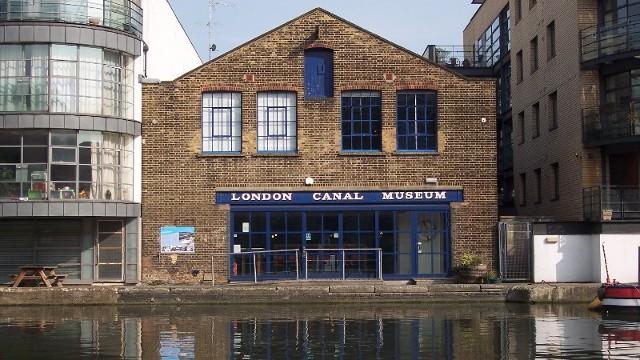


London Canal Museum in the King's Cross area of London, England, is a regional museum that displays information about the history of London's canals.
At the London Canal Museum you can see inside a narrowboat cabin, learn about the history of London's canals, about the cargoes carried, the people who lived and worked on the waterways, and the horses that pulled their boats. Peer down into the unique heritage of a huge Victorian ice well used to store ice imported from Norway and brought by ship and canal boat to be stored. This unique waterways museum is housed in a former ice warehouse built in about 1862-3 for Carlo Gatti, the famous ice cream maker, and features the history of the ice trade and ice cream as well as the canals.
There are two themes in this unusual London museum. London's canals have a fascinating past and you will learn not only how they came to be built but about the lives of the workers, the cargoes, horses and how canals work. We are a waterways museum first and foremost, but also an industrial museum telling the story of the ice industry in London. It is the only London museum of inland waterways and is situated at King's Cross, an accessible central location. It is suitable for adults and children and it is fully accessible to all visitors.
Accessibility
The museum is on two floors and the ground floor is divided into a street-level gallery (with level entrance) and a mezzanine area. Power operated sliding doors are installed at the entrance and these are usually automatic in operation, but sometimes have to be opened by staff for security reasons. Just knock on the door if the doors do not open right away.
Two lifts are provided. No staff assistance or key is needed to use them.An open platform lift carries you up to the mezzanine area. You can do it yourself, but staff will be pleased to help on request. There is access from the mezzanine floor to the wharf outside. A ramp is provided outside the rear door. From the mezzanine a second lift, this time an enclosed platform lift, takes you up to the first floor. Remember to press and hold the buttons that take the second lift up and down.
Virtual Tour of Cabin
The cabin of the narrowboat Coronis cannot be modified to provide access for wheelchairs because to do so would destroy it. The cabin demonstrates the cramped conditions in which the canal-boat families used to live.
As an alternative we have provided a virtual tour, at the entrance to the narrowboat. Using a track-ball you can explore the interior of the cabin. There are in fact two virtual tours. The first shows the cuboard doors closed, the second shows them open so you can have a look inside. You will be surprised at the excellent view of the cabin that you will have.
The computer that provides the virtual tour also offers the mini-drama using a pair of headphones. Put on the headphones and click on the button in the bottom right hand corner of the screen to listen to the sound track.
Exhibitions
We have tried to ensure that our exhibitions are as friendly as possible to wheelchair users. Almost all displays can be seen and texts read from a wheelchair. In a number of cases we have provided hanging books attached by a chain as an alternative for wheelchair users. For example, the two flip-books that explain a lot of extra detail about horses on the streets and canals of London, and about Carlo Gatti and the Ice Trade, are at a height suitable for most people. Hanging book alternatives can be read on your lap.
The museum has a very large, detailed map of the London canal systeom on display in the first floor gallery. Due to the size of this exhibit the detail cannot be read from a wheelchair. We have therefore provided a separate low-level alternative version of the map on wall mounted swinging panels.
Lavatory
The disabled visitors' toilet is located near the main entrance. It is fully equipped for wheelchair users, and fitted with an alarm. If the alarm is activated staff will effect emergency entry with a key.
Shop
The shop is quite small and well stocked so you may not be able to reach everything. A low-level counter is provided. Staff will be happy to assist you to browse the books and souvenirs.
The museum is well provided for if your mobility is impaired. Access is level, the floor surfaces are firm, and there are lift alternatives to all staircases. If you prefer to use the stairs and can do so, there are handrails on both sides of every staircase. Both the main entrance doors and the door to the wharf are power operated and can easily be worked by pressing a button. The main entrance doors are usually automatic in operation but for reasons of security there are times when they are opened by staff to allow entry.
All the taps in all the toilets are lever operated and easy to use for visitors who cannot grip a knob. All toilets offer warm air hand dryers and paper towels. Mobility impaired visitors are welcome to use the disabled visitors' toilet.
Chairs are available on both floors if you need to rest.

